This was published 1 year ago
The wild region of Scotland the Queen would escape to
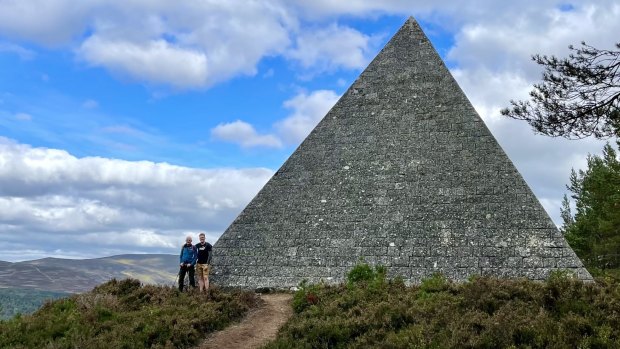
Albert's Pyramid was built on behalf of Queen Victoria in 1862 as a memorial to her beloved husband.Credit: Wilderness Scotland
After an uphill hike through an eerily still forest of Scots pine, we emerge into a clearing and are confronted by an imposing 10-metre-high stone pyramid. It's the last thing I expect to find in the UK's largest national park.
Albert's Pyramid was built on behalf of Queen Victoria in 1862 as a memorial to her beloved husband.
It's the biggest of 11 stone cairns dotted throughout the grounds of Balmoral Estate with this elevated vantage point offering sweeping views over Cairngorms National Park, a dramatic swathe of mountainous terrain an hour south-east of Inverness in the Scottish Highlands.
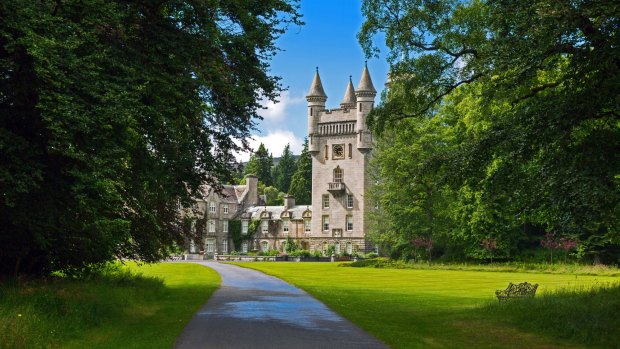
Balmoral.Credit: Alamy
Somewhere within the moat of dark green forest in the valley below is Balmoral Castle, the Royal Family's official Scottish home.
On this day in August last year, we're not permitted to visit because Queen Elizabeth II is in residence, a fact that will acquire poignant significance the following month when she dies peacefully at her beloved estate.
Albert's Pyramid is the first of many surprises we'll encounter during this seven-day hiking trip in the Cairngorms with Wilderness Scotland.
There'll be plenty of whisky, haggis and bagpipes, too, but our group of eight soon learns there's much more to this region than just predictable Scottish stereotypes. And despite its size and seemingly timeless terrain, it's a landscape that's in the midst of a pivotal period of change.
A right royal affair: a lap around Loch Muick
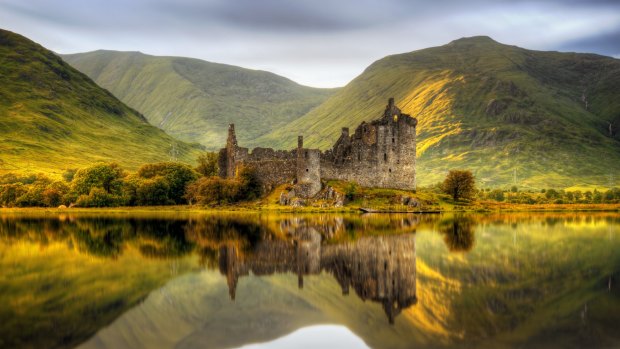
"She just loves it here. She's always very sad when it comes to the end of her visit." This quote comes from a former Balmoral estate employee and is part of a display for the late Queen's Platinum Jubilee in St Margaret's church in Braemar.Credit: iStock
It sums up the late Queen's enduring fondness for the region. The Cairngorms' secluded glens and isolated peaks offered a much-needed respite from the public eye. During our week-long tour, we constantly trip over royal reminders.
For the first few nights we stay at the delightful Cranford Guest House in Braemar, a town of sturdy stone houses surrounded by soaring heather-cloaked hills. Home to the ruined 14th-century Kindrochit Castle, it's also the venue for the annual Braemar Gathering, the most famous of Scotland's Highland games.
Dating back more than 900 years, the event in September is a tartan-clad frenzy of dancing and pipe bands with fiercely competed contests including caber tossing and hammer throwing.
Those royal connections keep emerging when I learn that the event was first attended by Queen Victoria in 1848, the gathering was regularly patronised by the Queen and it's expected King Charles III will continue the tradition.
Our first big hike is a 12-kilometre circular trek around Loch Muick, a brooding, tannin-stained lake flanked by steeply rising hills, including the 1155-metre Lochnagar, one of the Cairngorms' 55 Munros (peaks over 914 metres).
After tracing the shoreline on a gravel track lined with purple heather and dotted with bright yellow and orange flowers, we follow a narrow path uphill, past a cascading waterfall and into a yawning natural amphitheatre that cradles Dubh Loch.
To the east is a majestic view back over Loch Muick; to the west is a dramatic curtain of 300-metre granite cliffs. There is not another soul around. "Now this is proper Scottish wilderness," says Iain Taylor, our guide.
It's a wilderness that so inspired the future King Charles III that in 1980 he wrote a children's book called The Old Man of Lochnagar, which was based on a story he used to tell his younger brothers Andrew and Edward.
On the way back to the car park, we pass Glas-allt-Shiel, the lakeside "widow's house" that Queen Victoria built in 1868 as a place to mourn her husband's death.
We also pass two runners inexplicably dressed in only shorts and singlets. It's August (so allegedly summer), but for most of the hike I've been sporting a beanie, three base layers and a puffer jacket.
Clearly, I don't hail from these parts and we have a similar encounter the following day while tackling a 17-kilometre circular trail that starts at Mar Lodge Estate on the outskirts of Braemar.
After beginning on a wide floodplain carved by the River Dee, we head up into a disorientating maze of windswept glens.
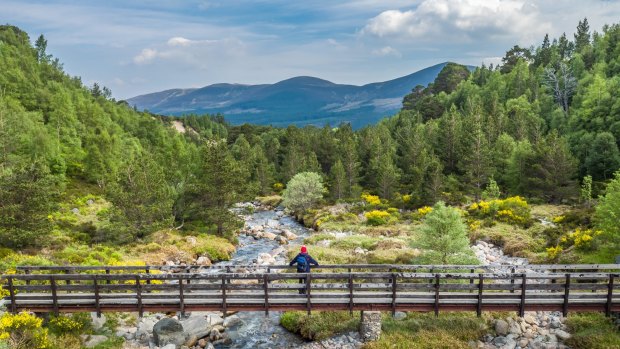
Credit: Visit Scotland
Shortly after stopping for lunch by a tranquil loch dotted with mallards, a group of five 17-year-old girls in T-shirts and shorts comes marching past shouldering towering backpacks.
It turns out they're completing their Duke of Edinburgh's Gold Award, a scheme started in 1956 by the Queen's late-husband to encourage youngsters to broaden their life skills through volunteering, physical recreation and outdoor adventure. The girls will spend three nights in this foreboding wilderness, navigating with paper maps and carrying all their own camping equipment and food. I'm not sure I'd last a day.
A changing landscape: Into an emerald wasteland
"Scotland is now a green desert," says Alan Smith, outdoor learning and engagement manager at Cairngorms National Park Authority. A friend and former colleague of our guide, he's joined us for a stroll through Abernethy National Nature Reserve near the popular tourist hub of Aviemore.
He explains that centuries of human intervention, including deforestation and peat bog draining has turned much of the Cairngorms into a monoculture.
The region's distinctive moorland heather (which is resplendent with bright purple flowers during our visit) has been excessively cultivated because it's one of the primary food sources for grouse and deer.
Along with pheasant, partridge and ptarmigan, they are the main quarry for a lucrative annual shooting season where people part with thousands of pounds to pepper them with shotgun pellets. For grouse, the season starts on August 12, a day known locally as "The Glorious Twelfth".
This reserve not only provides a safe haven for many rare and threatened species, but it is also one of the largest surviving fragments of original Caledonian pine forest, a fertile habitat that once covered most of the country.
Today, less than one per cent of it remains, but it's not all bad news. Cairngorms Connect is an ambitious 200-year project that hopes to restore vast tracts of the region's natural habitats through a partnership between neighbouring land managers.
Part of the challenge is that great swathes of the national park have been bought by wealthy foreign investors, the most prolific of whom is Danish billionaire Anders Povlsen, the UK's largest private landowner.
Fortunately, he's also a fervent advocate for rewilding, evidence of which we see first-hand during a hike through Glen Feshie, a spectacular valley in the north-west of the park that he bought in 2006.
He's removed thousands of deer from the property, which has allowed native trees and bushes to regenerate and has encouraged the return of threatened species such as the capercaillie (the largest member of the grouse family).
Smith also tells us about the 2003 Land Reform Act, which is best known for providing universal land access across Scotland for recreational and educational use (the so-called "right to roam").
Less publicised is that it also gives communities first refusal on nearby land being sold. Many Highland settlements were cleared during the 1800s to make way for sheep farming. This act hopes to encourage them to return. "It's re-peopling as well as rewilding," says Smith.
Abernethy National Nature Reserve is a bucolic reminder of how the lowland fringes surrounding the Cairngorms' raised alpine plateau would have looked before humans started meddling with them.
Strolling through a fecund forest of pine, rowan and birch, Smith points out scarlet-coloured toadstools, fragrant juniper shrubs and spongy, bright green sphagnum moss.
We sample sweet wild blaeberries and tart, apple-flavoured wood sorrel. While pausing for a snack near the shoreline of the peat-stained Loch Garten, we're pelted by pine cones from a rare Scottish crossbill feeding in the tree above.
The reserve's most famous avian residents are a pair of ospreys, a migratory species that became extinct in the UK during the early 1900s due to hunting and egg theft.
A pair returned here in 1959 and thanks to the efforts of local conservationists, the number of breeding pairs in Scotland is now about 250. Visitors to the reserve can see the nest and its resident chicks via cameras and telescopes in the excellent information centre run by the Royal Society for the Protection of Birds.
Beyond black pudding: A Highlands foodie fling
One of the great rewards of a day spent in the Scottish outdoors is the excuse to indulge in an extravagant amount of hearty fare each night. And nowhere does hearty fare quite like Scotland.
Life-threatening specialties such as black pudding and deep-fried Mars bars get all the headlines but there are plenty of less-deadly delicacies worth trying too.
Highlights during the trip include pan-seared Scottish king scallops, a juicy venison steak, and cullen skink, a deliciously rich soup containing smoked haddock, potatoes and onions.
Of course, a whisky tasting is practically compulsory in these parts and Royal Lochnagar Distillery delivers the goods, providing an informative guided tour followed by a selection of some of its finest single malts.
For the second half of the trip, we're based on the outskirts of Newtonmore in the lovely Coig na Shee guest house. Dinner each night is BYO and the bottles on the table reflect our group's origins – a South Australian shiraz for me and a selection of merlots and cab savs for the group's three American couples.
For our patriotic Glaswegian, Ed, there's only one choice of liquid refreshment – a two-litre bottle of Scotland's "other" national drink, Irn-Bru, a lurid orange soft drink that was once advertised with the tagline: "Made in Scotland from girders".
Trails of the unexpected: Of reindeer and pixies
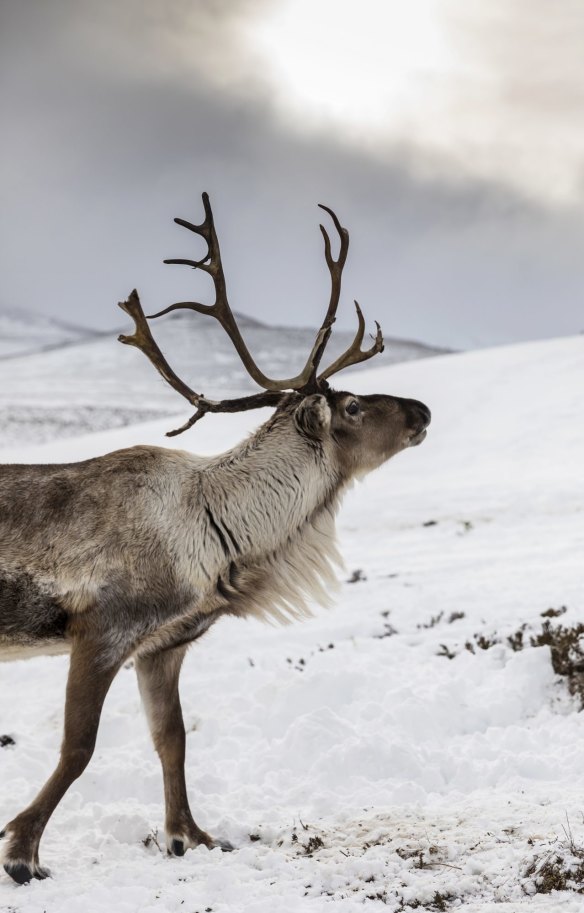
Credit: Visit Scotland
The appeal of this trip is that it skilfully combines experiences that the Cairngorms is famous for – hikes through dramatic scenery, visits to whisky distilleries and traditional Highlands culture – with things that it isn't.
I had no idea that the region was home to the UK's highest public road (the Cairnwell Pass between Glenshee and Braemar), some of the UK's tallest trees (in Diana's Grove in the grounds of Blair Castle), four of the UK's five highest mountains and Britain's only free-ranging herd of reindeer.
We learn this last fact on our final day during a visit to the Cairngorm Reindeer Herd in Glenmore. Wild reindeer were once native to the UK but were wiped out by hunting about 800 years ago.
The owners of this centre started reintroducing them from Sweden in 1952 and now they have a herd of around 150 that spends most of the year grazing on 4000 hectares of elevated mountainous terrain.
The Cairngorms is the only place in the UK that can support reindeer because it closely mimics their sub-Arctic homeland.
The centre runs guided tours to visit the herd and you can even adopt one. At the time of writing, candidates listed on the website include Minsk, Florence and the "greedy but sweet" Marple.
From the Glenmore Visitor Centre, we embark on our last hike – a 10-kilometre out-and-back trek along the Ryvoan Trail.
It's a typical Cairngorms summer's day – sunny one minute, raining the next, the sky a restless tussle between billowing clouds.
The trail starts with a steady climb on a gravel track through a dense pine forest until we reach An Lochan Uaine (The Green Loch), a picturesque freshwater lake whose emerald green colour is caused by pixies washing their clothes in it (so local legend asserts).
Our destination is Ryvoan bothy, one of about a dozen sturdy mountain huts in the Cairngorms that provide temporary shelter and free overnight accommodation. We huddle inside its spartan stone-walled interior, shedding layers alongside two other groups of hikers.
Outside the midges are nibbling and the wind is whistling but here the atmosphere is warm and convivial as people pore over maps and share flasks of hot tea.
A look through the guest book reveals enthusiastic comments by visitors from around the world, all of whom seem equally entranced by this mystical landscape. Perhaps Xavier sums it up best with his simple four-word entry on August 28: "No words now. Speechless."
Rob McFarland was a guest of Wilderness Scotland wildernessscotland.com
FIVE MORE SPECTACULAR SCOTTISH LANDSCAPES TO SAVOUR
GLENCOE
Famous for appearing in the closing scenes of the James Bond film Skyfall, this steep-sided, glacier- carved valley in the Highlands is a popular destination for hikers and climbers. See visitscotland.com
ORKNEY
Situated off the north coast of mainland Scotland, this rarely-visited archipelago of about 70 islands is peppered with fascinating archaeological sites documenting more than 5000 years of human habitation. See orkney.com
LOCH NESS
You probably won't see its mythical resident Nessie, but this 37-kilometre-long lake near Inverness is still one of the country's most alluring and dramatic lochs. See visitinvernesslochness.com
OUTER HEBRIDES
This chain of islands off Scotland's west coast is known for its rich Gaelic heritage and deserted white- sand beaches. Active types can tackle the Hebridean Way, a 250-kilometre walking trail that crosses 10 of the islands. See visitouterhebrides.co.uk
LOCH LOMOND AND TROSSACHS NATIONAL PARK
Scotland's first national park is a diverse medley of mountains, lakes and forests centred around the aquatic wonderland that is Loch Lomond. See lochlomond-trossachs.org
THE DETAILS
WALK
Wilderness Scotland's seven-day Cairngorms National Park & Royal Deeside tour starts and ends in Inverness and includes all accommodation, meals, entrance fees and transfers. This trip is rated as "green graded", meaning it's suitable for active travellers who are reasonably fit and enjoy moderate hikes. The maximum group size is eight. From £1885 ($3290) a person, twin share. See wildernessscotland.com
KNOW
The walk operates from mid-April through September. To avoid the worst of the local insects, consider visiting before July or towards the end of September. Whenever you go, be prepared for changeable weather.
FLY
British Airways has direct flights from London Heathrow to Inverness. EasyJet also flies direct from London Gatwick. See britishairways.com; easyjet.com
Sign up for the Traveller Deals newsletter
Get exclusive travel deals delivered straight to your inbox. Sign up now.